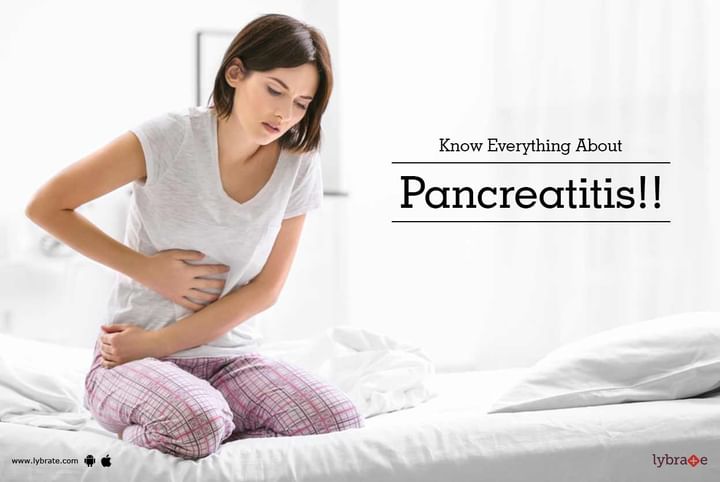Know Everything About Pancreatitis!!
What is Pancreas?
The pancreas is an organ placed behind the stomach in abdomen. It produces: digestive juices (produce by exocrine pancreas, it help in digestion of food) as well as digestive hormones i.e. insulin and glucagon (produce by endocrine pancreas) which help in regulation of the level of glucose (sugar) in the blood.
What is pancreatitis?
Pancreatitis is abnormal swelling and inflammation of the pancreas. Once the gland becomes inflamed, the condition can progress to swelling of the gland and surrounding blood vessels, bleeding, infection, and damage to the gland. Normally, digestive enzymes secreted by the pancreas do not become active until they reach the small intestine. But when the pancreas is inflamed, digestive juices become trapped and start "digesting" the pancreas itself. If this damage persists, the gland may not be able to carry out normal functions.
What Are the Types of Pancreatitis?
Pancreatitis may be acute (new, short-term) or chronic (ongoing, long-term). Either type can be very severe, even life-threatening. Either type can have serious complications.
- Acute pancreatitis usually begins soon after the damage to the pancreas begins. Attacks are mostly very mild, but about 20% of them are very severe. The onset of acute pancreatitis is often very sudden. The inflammation usually clears up within several days after treatment begins. An attack lasts for a short time and usually resolves completely as the pancreas returns to its normal state. Some people have only one attack, whereas other people have more than one attack, but the pancreas always returns to its normal state unless necrotizing pancreatitis develops and becomes life-threatening.
- Chronic pancreatitis begins as acute pancreatitis. If the pancreas becomes scarred during the attack of acute pancreatitis, it cannot return to its normal state. The damage to the gland continues, worsening over time. Pancreatitis can come and go quickly, or it can be a chronic problem. Treatment will depend on whether your pancreatitis is acute or chronic.
What are the causes of pancreatitis?
Alcohol abuse and gallstones are the two main causes of pancreatitis, accounting for 80% to 90% of all individuals diagnosed with pancreatitis.
- Gallstones form from a buildup of material within the gallbladder, another organ in the abdomen (please see previous illustration). A gallstone can block the pancreatic duct, trapping digestive juices inside the pancreas. Pancreatitis due to gallstones tends to occur most often in women older than 50 years of age.
- Pancreatitis from alcohol use usually occurs in individuals who have been long-term alcohol drinkers for at least five to seven years. Most cases of chronic pancreatitis are due to alcohol abuse. Pancreatitis is often already chronic by the first time the person seeks medical attention (usually for severe pain).
- The remaining 10% to 20% of cases of pancreatitis have various causes, including the following:
- medications,
- exposure to certain chemicals,
- injury (trauma), as might happen in a car accident or bad fall leading to abdominal trauma,
- hereditary disease,
- surgery and certain medical procedures,
- infections such as mumps (not common),
- abnormalities of the pancreas or intestine, or
- high fat levels in the blood.
- In about 15% of cases of acute pancreatitis and 40% of cases of chronic pancreatitis, the cause is never known.
What are the risk factors for pancreatitis?
The major risk factors for pancreatitis are excessive alcohol intake and gallstones. Although the definition for excessive alcohol intake can vary from person-to-person, most health-care professionals suggest that moderate consumption is no more than two alcoholic drinks a day for men and one a day for women and the elderly. However, people with pancreatitis secondary to alcohol intake are usually advised to avoid all alcohol intake. Other risk factors include:
- a family history of pancreatitis,
- high levels of fat (triglycerides) in the blood,
- cigarette smoking,
- certain inherited disorders such as cystic fibrosis, and
- taking certain medicines (for example estrogen therapy, diuretics, and tetracycline).
What Are the Symptoms of Pancreatitis?
Most people who have acute or chronic pancreatitis experience upper abdominal pain as their primary symptom. Some of those who have chronic pancreatitis may show inflammation on imaging scans, but otherwise may show no symptoms. Symptoms of pancreatitis may include:
- upper abdominal pain: pain that wraps around the upper body and involves the back in a band-like pattern
- Pain associated with pancreatitis may last from a few minutes to several hours at a time.
In severe cases, discomfort from chronic pancreatitis could become constant. Your pain is likely to increase after you eat or when you’re lying down. Try sitting up or leaning forward to make yourself more comfortable.
- indigestion
- nausea or vomiting
- abdominal tenderness
- unintentional weight loss
- bloating with a distended (swollen) stomach
- hiccups
Severe acute pancreatitis is a medical emergency. Severe acute pancreatitis may cause dehydration and low blood pressure. The heart, lungs, or kidneys can fail. If bleeding occurs in the pancreas, shock and even death may follow. People who have chronic pancreatitis may also experience steatorrhea, or fatty stools that give off a foul odor. Steatorrhea can be a sign of malabsorption. This means you’re not getting all of your essential nutrients because your pancreas doesn’t secrete enough digestive enzymes to break down your food.
How pancreatitis is diagnosed?
Your doctor will likely use a combination of blood tests and imaging scans to make a diagnosis. If you have acute pancreatitis, blood tests may show a rise in your level of pancreatic enzymes. During acute pancreatitis, the blood contains at least three times the normal amount of amylase and lipase, digestive enzymes formed in the pancreas. Changes may also occur in other body chemicals such as glucose, calcium, magnesium, sodium, potassium, and bicarbonate. After the person's condition improves, the levels usually return to normal. Ultrasound, MRI/MRCP, and CT scans can reveal the size of your pancreas and whether you have a blockage of the bile ducts.
How to treat pancreatitis?
Treatment for acute or chronic pancreatitis often involves hospitalization. In acute pancreatitis, the choice of treatment is based on the severity of the attack. If no complications are present, care usually focuses on relieving symptoms and supporting body functions so that the pancreas can recover. Treatment for acute pancreatitis includes intravenous (IV) fluids, and medications for pain, nausea and vomiting.
- The pancreas is key to your digestive process and needs to rest to heal. No food or liquid should be taken by mouth for a few days. This is called bowel rest. By refraining from food or liquid intake, the intestinal tract and pancreas are given a chance to start healing.
- For this reason, you may receive fluids and nutrition intravenously or through a tube that goes from your nose directly into your jejunum (part of small intestine), which is called a nasojejunal feeding tube. Restarting an oral diet depends on your condition. Some people feel better after a couple of days. Others need a week or two to heal sufficiently.
- If needed, medications for pain and nausea are prescribed.
- Those people who are having trouble breathing are given oxygen.
- Antibiotics are given if the health-care professional suspects an infection may be present.
- Some people may need a nasogastric (NG) tube. The thin, flexible plastic tube is inserted through the nose and down into the stomach to suck out the stomach juices. This suction of the stomach juices rests the intestine further, helping the pancreas recover.
- If the attack lasts longer than a few days, nutritional supplements are administered through an IV line.
- Surgery is sometimes needed to treat complications
- If your doctor diagnoses gallstones or other blockages of the bile ducts, you may need surgery to correct these problems later on.
What are the complications of pancreatitis?
Some patients may develop complications. These complications are rare, but they’re more common in people with chronic pancreatitis:
- kidney damage
- pancreatic cancer
- diabetes
- malnutrition
- pancreatic infection
- Patients who have acute pancreatitis may also be at risk for developing breathing difficulties.
Can pancreatitis be prevented?
The following recommendations may help to prevent further attacks or to keep them mild:
- Completely eliminate alcohol because it is the only way to reduce the chance of further attacks in cases of pancreatitis caused by alcohol use, to prevent the pancreatitis from worsening, and to prevent the development of complications that can be very serious or even fatal.
- Eat small frequent meals. If in the process of having an attack, avoid solid foods for several days to give the pancreas a chance to recover.
- Eat a balanced diet high in carbohydrates and low in fats because may help individuals decrease the risk for pancreatitis since it is likely these actions will decrease the risk of gallstones, a major risk factor for pancreatitis.
- If pancreatitis is due to chemical exposure or medications, the source of the exposure will need to be found and stopped, and the medication will need to be discontinued.
- Don't smoke
- Maintain a healthy weight
- Exercise regularly. If you wish to discuss about any specific problem, you can consult a Gastroenterologist.



+1.svg)
